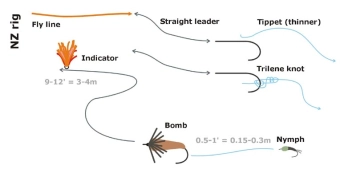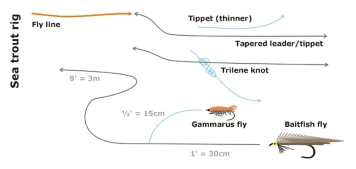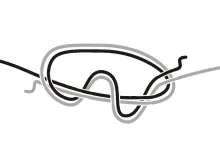Having more than one fly on your leader actually makes pretty good sense in the very simple way that presenting more than one temptation to the fish increases the chance of a bite. But there are many other reasons.
An important notice
You will find many places on the fly fishing map where several flies on one line is illegal.
Please observe these rules and make sure you don't fish illegally when you add an extra fly.
Having more than one fly on your leader actually makes pretty good sense in the very simple way that presenting more than one temptation to the fish increases the chance of a bite.
But even though this reason might seem pretty obvious and straightforward, it isn't the only reason for adding an extra fly or two to your rig. Most people fish with more than one fly in order to have the flies appear differently in the same cast.
This difference can be in depth, but of course it can also in size, visibility, mobility or other aspects.
This article tries to cover some of the reasons and solutions to fish more than one fly, and tries to teach you how to rig them and how to cast and fish them.
The indicator
The first and most obvious reason to put on an extra fly in my eyes, is to exchange a strike indicator in a nymph rig with a fly. Rather than having a piece of foam, yarn, putty or whatever you use, as an indicator, you might as well have a fly that can lure the fish and maybe even provoke a bite.
It didn't take many strikes on the indicator in the beginning of my nymphing career before I switched the foam for a large dry fly.
My personal favorite indicator fly is a large, colorful foam hopper. Size 6 or 4 is fine. It's visible, it's buoyant and it's a common food item on most waters. I have caught fish on hoppers in many waters. The worst case is that you simply have a hook in your colorful indicator. The best case is that you have so much action on your hopper, that you end up cutting off the nymph.
Hopper, Copper, Dropper
A very famous and widely used hopper-nymph rig is the so called Hopper-Copper-Dropper setup. You use a hopper on top, then a heavy nymph - oftentimes a Copper John or a similar fly, hence the name - and then a small lightweight nymph as the dropper.
The hopper floats the party, the Copper John sinks and brings down the smaller nymph, which would have a hard time sinking on its own.
The rig can be deadly, and enables you to fish in three depths: surface, midwater and deep, and also enables you to fish very small flies almost on the bottom (depending on water depth of course).
I hate casting this setup! It's bound to tangle now and then, and sometimes cutting the tippet is the only way to get things "untied".
But using a proper taper through the rig can help. A sturdy and not too long leader with a short piece of tippet to the hopper. Then a fair amount of thinner tippet to the heavy nymph. I often use 2-3 feet or even more depending on the depth, and then about a foot or so of fine tippet to the final fly, the dropper. It's still a menace to cast, but doable. A long rod, like a 8-9' 5 weight, and a gentle casting stroke will help a lot.
Cast, mend the hopper upstream a bit and watch it closely. Any bobbing indicates a nibble, and if it dives, you set the hook. But don't be surprised to see obvious splashy attacks on the hopper itself!
I use surgeon's knots for this rig.
NZ rig
The New Zealand rig is based on a slightly different principle. Here you fish a large fly like a cicada or some other tempting morsel, trailed by a small nymph. The top fly is often fished sub surface, and sometimes it's actually very heavy, to an extent that makes it difficult to cast. This particular rig is often called a Tongariro Nymph Rig, named after its birthplace on the Tongariro River. This particular rig uses a normal yarn indicator, followed by a very heavy nymph (very!) aptly called the Bomb, followed by another smaller nymph.
The system is set up with up to 9 feet or 3 meters straight mono from the fly line to the first nymph and a foot or less to the second. Tapers are not really needed since the Bomb is so heavy that it turns over the whole rig with its weight alone.
Since the whole thing is far from easy to cast, the Kiwi's have developed the Tongariro Haul or Tongariro Roll Cast (TRC) to propel it out. The final phase of haul is quite similar to the Scandinavian style underhand cast where the leader "sticks" to the water next to the angler and the whole thing is propelled out by a snappy roll cast like motion, but the motions leading up to that snap is a weird combo of a Spey cast and some line folding that was definitely invented somewhere where people say G'day mate!
The Kiwi's also traditionally tie the second fly to the hook bend of the first one in stead of using a tag on the leader, a method that I have adapted for most of my two fly rigs and the only thing that I have picked up from this method used down under.
I use a Trilene knot for this rig.
In this video you can see the Tongariro haul in all its might.
Video: Anglers Anonymous.
British team
Fishing teams of flies is almost an institution in the UK and Ireland. Teams are sets of flies combined in a certain way using certain specific patterns or at least pattern styles. These teams are used almost exclusively for lake fishing and that is often performed from boats, although bank fishing is also seen.
The rigs consist of two or three flies tied on very long leaders and fished with equally long rods. 10 foot leaders extended with two times three feet aren't uncommon, and that calls for a light 11 or 12 foot rod.
There is usually no taper and a successful cast depends very much on the wind. You fish with your back to the wind drifting the boat sideways using a drift anchor or two.
You cast away from the wind and drift over the cast, retrieving line while the flies sink and you get closer to the top fly. Sometimes you fish the setup actively, creating a small wake from the top fly. Other times you fish it dead drift and keep an eye on your top fly or the leader and line as it sinks.
I use the surgeon's knot for this rig.
Simply two flies
When fishing on the coast in the Baltic for sea run sea trout it does happen that I tie on two flies. I do it mainly to be able to fish one large and one small fly, and generally use the NZ way of attaching the smaller fly to a tag tied to the hook bend.
When fishing baitfish imitations I sometimes tie the smaller fly to a tag above the imitation, mostly a gammarus imitation, in the belief that it might look like the larger fly is chasing the smaller one. I tell myself that this will either make a trout envious and make it go for the prey, or trick a trout into believing that the baitfish is so busy that it won't notice that it itself is being chased.
I have no idea if either is the case or what makes this work, but I know from spinning anglers that adding a fly in front of the lure (called ophænger in Danish - hanging above) can increase catches significantly.
When I tie on a fly above the main fly, I use a sliding tag, tied on the main leader or tippet using a Trilene knot.
The two fly rig can be cast and retrieved almost as when using one fly, even though it does pay not to use the most aggressive casting style, powerful double hauls and the narrowest casting arcs you can muster. Tangles are best avoided with slower casting strokes and open arcs.
Easy does it when fishing with more than one fly.
I use a Trilene knot for this rig - both in the hook bend and when using a tag.
So, will you catch more than one fish at a time?
Well, it's a natural question, and it can be answered with a definite maybe! I have caught two fish on a multi-fly rig two times in my life. Once in Wales where I landed both (image added as a proof) and once on the coast here in Denmark, where I hooked a decent trout on the larger fly and a really small one took the small fly as I was landing the big one. The small one got off, the big one got eaten - by my family and I.
Having two fish at a time is not the goal, and actually counterproductive, since they will fight each other with a very short, taught line between them and no subtle rod tip to absorb the violent, wiggly dance that fish usually perform when hooked. One will most likely get loose and in the worst case they will both break off. I would usually avoid using multiple flies when small, stupid and hungry fish are around, and I would probably also stay with one fly if fishing for strong, schooling fish such as bonefish, tuna, albacore or the like. Two of those critters on one line is destined to go wrong!
Once you get the hang of fishing more than one fly you suddenly get strange ideas. I told the story here about my Swedish lake fishing where two flies at a time made a nice difference. Just try it, experiment and do things differently.
These articles also touch upon knots and/or fishing multiple flies
Hand picked for this article
- Log in to post comments



























I have recently disc
I have recently discovered tippet rings. These tiny (2mm or 3mm) allow the angler to tie knots to the rings and the main purpose is to change or renew the tippet without changing the length of the leader. However, I also use them to add one or more droppers. Follow me as I add the tippet ring to the leader. I tie the tippet to the ring and I tie a nymph to the end of the tippet. I now take a short piece of tippet material and tie a second fly to the tippet. This piece of tippet is tied to the ring and I now have two flies that fish in the desired depth. I can add weight above the tippet ring or on the tippet between the two flies. If I knew I could control my casting I could follow the same procedure and use a third fly on another dropper.
We have all been on the stream when suddenly, fish start to rise. All I have to do is clip the dropper from the ring and clip the lower fly from the tippet. Add the dry fly to the end of main tippet and you are ready for the rising fish.
There are many other possible combinations, but that is a basic primer.
Have fun and release the wild ones.
Clint